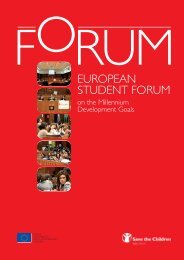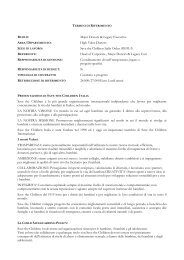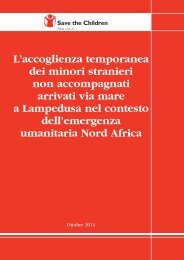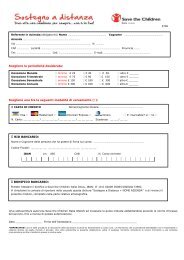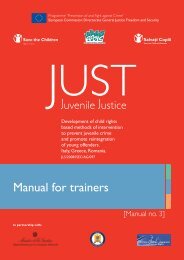FINAL REPORT - Save the Children Italia Onlus
FINAL REPORT - Save the Children Italia Onlus
FINAL REPORT - Save the Children Italia Onlus
Create successful ePaper yourself
Turn your PDF publications into a flip-book with our unique Google optimized e-Paper software.
IIIPART<strong>FINAL</strong> <strong>REPORT</strong>Development of a Child Rights Methodology to Identify and Support Child Victims of TraffickingMETHODOLOGICALFRAMEWORK No. 9Table of ProceduresIN-DEPTH INTERVIEW ON THE CHILD’S EXPERIENCEFirst stepThe interviewer will start <strong>the</strong> interview, in <strong>the</strong> respect of <strong>the</strong> indications presented in<strong>the</strong> above tables. He/she will present himself/herself to <strong>the</strong> child and will discussabout his/her experience in interviewing children. He/she will also introduce o<strong>the</strong>rprofessionals who may be present in <strong>the</strong> course of <strong>the</strong> interview.Interviewing <strong>the</strong> childThe interviewer is aware of <strong>the</strong> indicators of identification informing <strong>the</strong> presumptionthat <strong>the</strong> child is a victim of trafficking. He/she also has ga<strong>the</strong>red <strong>the</strong> opinion ofo<strong>the</strong>r professionals that have come in contact with <strong>the</strong> child.A checklist of questions is available, selected on <strong>the</strong> basis of an individual case assessment.If personal data and social history information was not collected in <strong>the</strong> initial interviewor when <strong>the</strong> child was detected, <strong>the</strong> interviewer will seek to obtain it at this stage.Specific questions will be asked in relation to <strong>the</strong> indicators already identified. Fur<strong>the</strong>rquestions will be asked to gain additional knowledge on topics raised in <strong>the</strong> interview by<strong>the</strong> child.If it is in <strong>the</strong> child’s best interest, <strong>the</strong> interviewer will focus <strong>the</strong> discussion only on alimited number of topics and will postpone fur<strong>the</strong>r questioning.Topics to be coveredThis table describes what professionals should do in <strong>the</strong> differentsteps of <strong>the</strong> interview and also provide a list of topics to becovered and examples of checklists.Indications given shall be considered with flexibility. Nationalstakeholders shall take into consideration and add any elementthat although not suggested under <strong>the</strong> AGIS methodology, mightbe relevant to include in <strong>the</strong>ir national or local context.<strong>FINAL</strong> <strong>REPORT</strong>Development of a Child Rights Methodology to Identify and Support Child Victims of Trafficking3. How much money do you earn daily? Haveyou been asked to reach a certain dailyamount?4. Do you keep <strong>the</strong> money for yourself or doyou give it to someone else?5. Can you describe your working day?ProstitutionExample of checklist:1. How long have you been conducting thisactivity?2. Do you follow any directions on how toconduct your work?3. Can you choose your clients?4. How do you ensure you earn enough to takecare of your needs?5. Can you describe your working day?Illegal activitiesExample of checklist:1. How long have you been conducting thisactivity?2. Do you follow any directions regarding <strong>the</strong>activity to be conducted?3. Have you been travelling within <strong>the</strong> country?4. Who are <strong>the</strong> persons you refer to?5. Is <strong>the</strong>re any group you belong to?6. Have you reached any agreement withmembers of <strong>the</strong>se groups - sharing ofresponsibilities, management of income...7. Have you ever been stopped by <strong>the</strong> policebecause of your activities?8. Is <strong>the</strong>re any person you go to if you needsupport?9. What do you do in your spare time?D) THREATS AND COERCIONto <strong>the</strong> location where <strong>the</strong> activity isconducted, money <strong>the</strong> child is forced to raise,management of <strong>the</strong> income obtained.Objective:• to ga<strong>the</strong>r information on <strong>the</strong> activity.Objective:• to ga<strong>the</strong>r information on <strong>the</strong> activity, transferwithin <strong>the</strong> national territory, relations withgroups (including criminal groups), relationswith o<strong>the</strong>r persons, involvement in <strong>the</strong> penalcircuit.IIIPARTA) PERSONAL SITUATION BEFORE AND DURING ENTRY TO THE COUNTRY,AND IN THE COUNTRY OF DESTINATIONExample of checklist:1. Did your family know you were travelling?Did someone help you arrange your travel?2. How long did <strong>the</strong> journey take? Where wereyou during that time?3. Did you have enough to eat and drink?4. Who did you travel with?Objective:• to ga<strong>the</strong>r information on <strong>the</strong> country and areaof origin, family, reasons of <strong>the</strong> child’sdeparture, living conditions during <strong>the</strong> journey,persons involved;• to identify elements to classify <strong>the</strong> situation astrafficking.Example of checklist:1. Did someone ask you to perform thisactivity? Who was it and why did <strong>the</strong>y askyou?2. Where were you contacted? Were anypromises made to you?3. Have you received any training prior toperforming <strong>the</strong> activity?4. Can you move freely? Are <strong>the</strong>re any rules youhave to respect?5. Are you scared of anything or anyone?6. What would you like to do in this situation?Objective:• where possible, to follow up on informationalready given by <strong>the</strong> child and ga<strong>the</strong>rinformation on forms of recruitment,(including persons involved, informationreceived) training received, physical orpsychological threats, agreements reached with<strong>the</strong> exploiter, personal freedom, reaction to<strong>the</strong> described situation, relations with <strong>the</strong>exploiter or any o<strong>the</strong>r person mentioned,concerns, threats of reprisal.B) LIVING CONDITIONSE) PERCEPTION OF THE SITUATIONExample of checklist:1. Do you have any family in <strong>the</strong> country? Who?2. Do you pay for your accommodation? Whatis it like?3. How much money do you earn every week?Is it enough?4. What do you do during <strong>the</strong> day?Objective:• to ga<strong>the</strong>r information on living conditions in<strong>the</strong> country of destination;(persons involved, accommodation, dailyactivities conducted, network/s providingsupport to <strong>the</strong> child - if at all).1. What is it like to beg? Objective:• to ga<strong>the</strong>r information on how <strong>the</strong> childperceives his/her situation.F) FUTURE PLANS AND EXPECTATIONSC) MEANS OF SUBSISTENCE (availability of economic resources)Begging1. What do your parents think of your situation?What would <strong>the</strong>y like for you to do? Is thatwhat you want to do?Objective:• to ga<strong>the</strong>r information on <strong>the</strong> child’sexpectations regarding his/her future (incl.feeling that an agreement has to be respected,involvement of relatives.72Example of checklist:1. Since when have you been involved in begging?2. Is <strong>the</strong>re any adult you meet daily in this activity?Objective:• to ga<strong>the</strong>r information on <strong>the</strong> duration of <strong>the</strong>activity, persons involved, means of transport73



